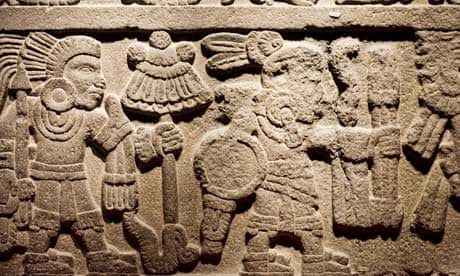The people widely known as the Aztecs called themselves Mexica, after their patron deity Mexi, who according to their legends brought them out of captivity into the region of Lake Tezcoco, at the heart of what is now modern Mexico, in the middle ages. In 1325AD they founded the city of Tenochtitlan on an island off the western shore of the lake. The city grew large and prosperous, and a war of independence from local overlords in 1428-30 led to it dominating the region. By the end of the 15th century the Mexica ruler, the "tlatoani", ruled over a powerful and growing empire. The tribute of neighbouring states helped make its capital splendid. In the lake city, radiating "suburbs" of the common people's houses surrounded the ruler's palace. Above that loomed a pyramid-like temple on whose high platform thousands of people died in mass sacrifices.
The deities who demanded such slaughter included Quetzalcoatl, the "feathered serpent", god of procreation, desire and the winds; Tezcatlipoca or "smoking mirror", the patron of rulers, warriors and magicians; and Tlaloc, god of rain. A complicated calendar and an elaborate festive cycle unified all the different gods and myths in one baroque system of intense beliefs. The sun, the calendar, and the gods are given visceral, yet sometimes unexpectedly delicate and moving form by the great works of Mexica art, which owes a lot to the art of the neighbouring Mixtec people. Mixtec craftsmen were employed by the Mexica for their superb skills. The results earned the admiration of the Renaissance artist Albrecht Dürer.
In 1492, a Genoese sailor named Columbus sailed west from Spain in search of the Indies. It was the ironic fate of this newest in a long line of native American city cultures to coincide with the coming of the Europeans – yet Mexica culture did not vanish with the fall of Tenochtitlan in 1521. Native artists continued to make painted books telling their history in the "glyphs" of their own pictorial script. Tenochtitlan itself rose again – as Mexico City. The Spanish built their colonial capital on top of the ruins of the fallen Mexica capital. Today, archaeologists are constantly finding spectacular art and artefacts under the streets of Mexico City. Mexico's famous Day of the Dead festival, with its grisly yet comic cavortings of the dead, recalls the skull motifs and the sacrifices of the lost world of Moctezuma. Mexico's pride in its past is reflected too in the desire to reclaim the "Aztecs" – as the Mexica.
